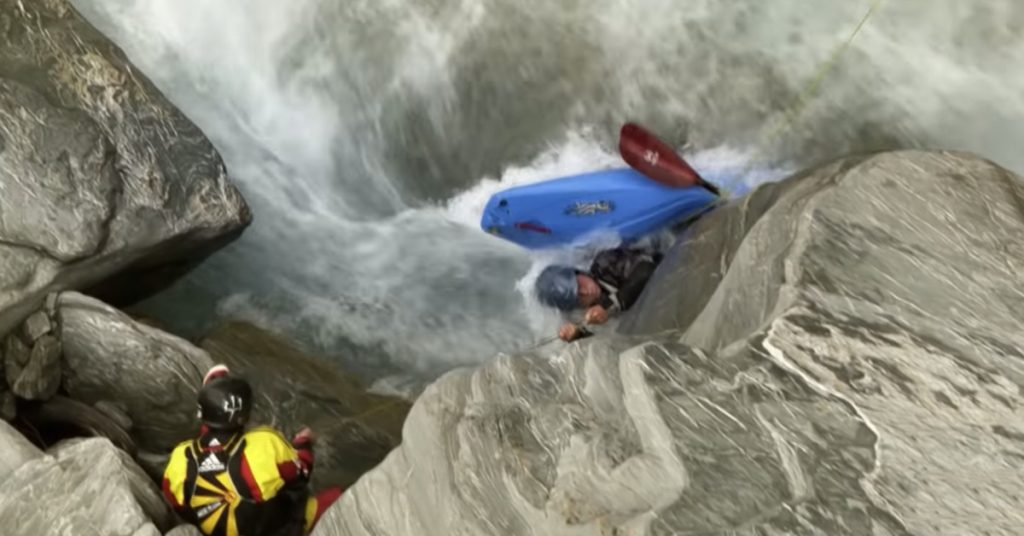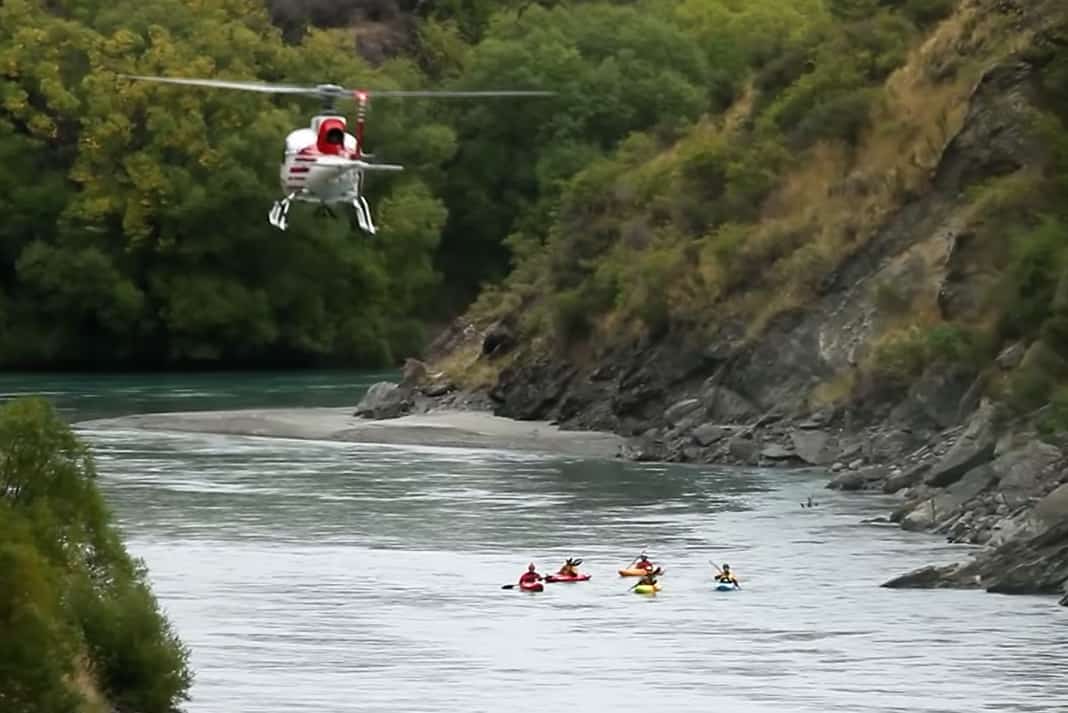This video highlights one of the greatest fears kayakers have on the river: getting caught in a sieve. Footage of this extreme kayak rescue shows why river safety is so important, and why all guides and professionals are trained in swiftwater rescue.
Setting the stage for trouble
The video was published back in 2015, but it remains a great example to talk about today. The story begins with a team of professional kayakers, including Rafa Ortiz and Rush Sturges, who head to Nevis Bluff Rapids on the Kawarau River in New Zealand.
The Kawarau River is big. In the video they mention this trip was planned after a few weeks of running smaller rivers, and switching to larger water was going to be a challenge.
“You look at it from shore. You look at it from every single different angle you can, but it just comes down to being in your boat and what ever you see when paddling through it. The water is changing every single second,” said Ortiz.
Sucked into a river sieve
Leading the group was local kayaker Jordy Searle, who had paddled the river a number of times and knew it well. As the group was making their way quickly downriver, Searle turned to give the group a thumbs-up signal. Just as he did this, Jordy’s boat was sucked into a sieve.
Among the most terrifying hazards a paddler can face, a sieve is a narrowing that forces rushing water beneath the rocks, where it can trap a kayaker and hold them under the surface.
The group quickly raced to shore, tossing throw bags to allow Searle a few extra breaths before going completely underwater. “It’s hard to put into words what it is like when you see somebody die,” said Sturges.
Waiting and hoping for the best
At this point there was not much the team could do without putting themselves at risk. They were just waiting, hoping that he would pop out on the other side.
As the seconds ticked past like hours, Sturges talks about the relief of seeing Searle finally come to the surface.

“It really makes you question how worth it, it really is. I mean, how many more drops, how many more rivers, how many more crazy rapids can you run before you lose a friend?” reflected Sturges.
Captured for posterity
In retrospect, it’s amazing that Ortiz and Sturges managed to capture this entire situation so clearly. Putting aside the adrenaline rush of sudden danger, Jordy Searle’s rescue was filmed at a time when drones were uncommon and paddlers instead had to arrange for a full-sized helicopter to follow them downriver.

Now, times are changing. Drones have become ubiquitous in a filmmaker’s tool kit, so these scary situations are more likely to be captured and shared. Such footage serves as a warning and a lesson that other paddlers would be wise to heed.
What can you learn from this extreme kayak rescue?
Whitewater can be humbling for even the most experienced river paddlers. A rescue such as this one stresses the importance of being properly trained in swiftwater river rescue techniques, and always ensuring you are outfitted with the proper safety equipment. Follow these steps, remain mindful of river hazards, and you will hopefully never star in a kayak rescue video of your own.




I’ve seen this clip before. Scary. On this viewing I think the opening shots show a different high volume river than the lower volume footage where the incident occurred. Maybe same river but totally different flow. Am I incorrect?
Outside TV played loose with identifying this footage. The intro is Nevis Bluff but the pin happened on the Kokathai River. I thought the same as Casey above so checked with Rush and he set things straight. More footage of Nevis Bluff is here: https://www.youtube.com/watch?v=WbtlN60WC6c
The pin definitely did not happen in Nevis Bluff on the Kawarau R. I felt the same way as Casey above so I touched base with Rush for clarification. Outside TV definitely took some editing liberties. The pin happened on the Kokathai River, a lower volume run.
I have been white water kayaking for 52 years now. I am 75 years old and still at it. I am a cruiser, not a stunt man, not a dare devil. I am not out to prove that I can paddle anything, but just that I had a great day on the water. I paddled with Walter Blakadar on the Middle Fork of the Salmon river in Idaho in 1969. He drowned in a sweep, as did a good friend of his. I have know several others that drowned. I portage stuff that I am not confident about. Often it is the best paddlers that drown, because they have too much to prove to themselves and others. There is one fellow that paddles in our group that is 85 years old, and still very good at It. Two ladies are about 77 years old and still running spring white water and loving it. Good thing they did not drown 30 years ago and could not enjoy this sport today.
Its a harrowing VIDEO but this is OLD, respectfully PADDLING MAGAZINE, we need new, and fresh articles/media!
That’s why they ask for people to enter their videos challenges at the end of the article.
This wasnt on the kawarau, 100% on the kokatahi on the west coast.
This is a great video to help teach how strainers effect swimmers and I’ve used it in the past for swift water rescue courses. Any chance the owner would release this video again? Thanks